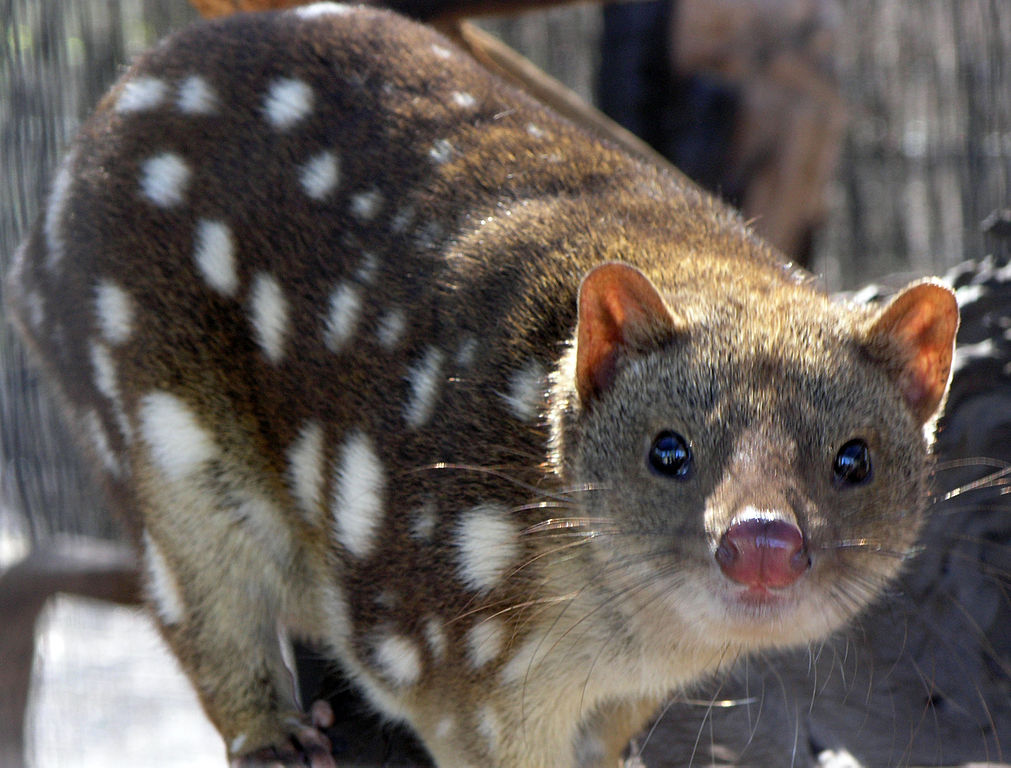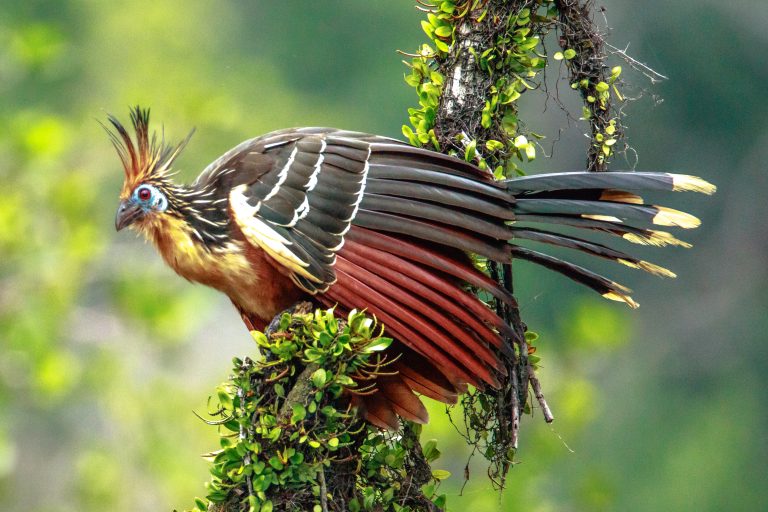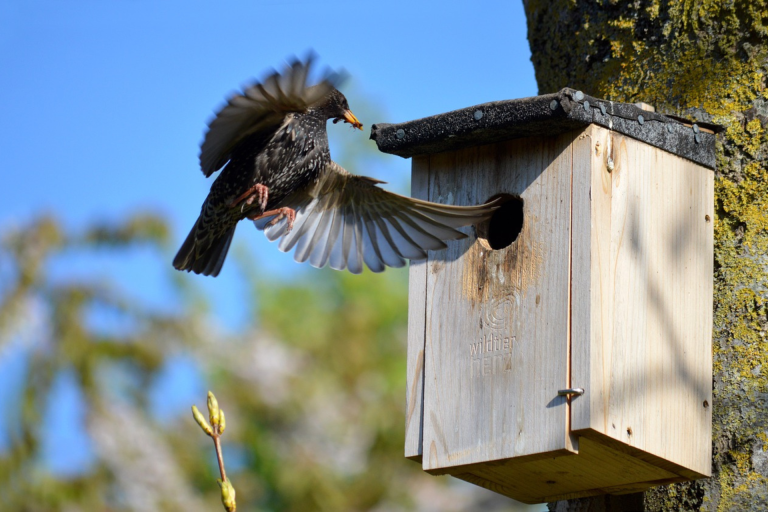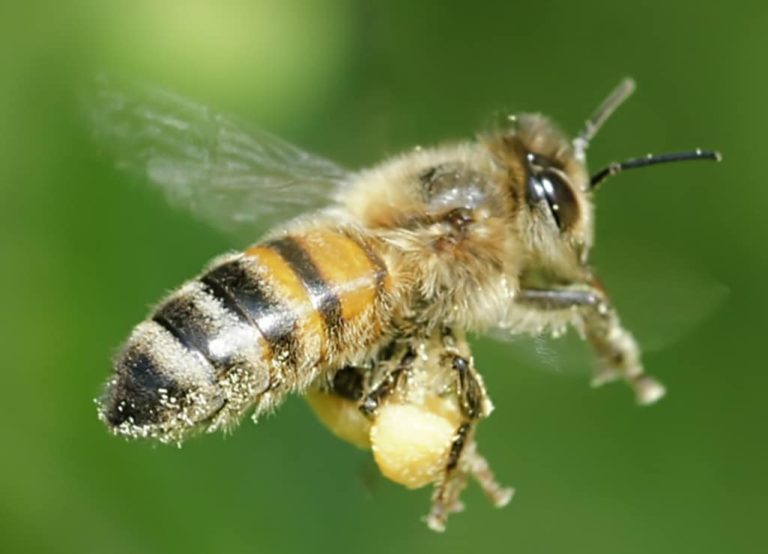Spotted Quoll: The Largest Carnivorous Marsupial of Mainland Australia
In this post, I will introduce the largest carnivorous marsupial found in mainland Australia, The Spotted Quoll.
What is The Spotted Quoll?
Let’s start with some basic facts about this unique animal.
Species Description
The Spotted Quoll is a marsupial, meaning it carries its babies in a pouch, like a Kangaroo.
It’s also a carnivore, meaning it kills other animals for food.
Scientific Classification
The Spotted Quoll is scientifically known as Dasyurus maculatus. This binomial name comes from Latin. The words Dasyurus and maculatus mean “hairy tail” and “spotted”.
This species belongs to the group called “quolls”. This group has several species, all carnivorous marsupials with spotted fur, and the Spotted Quoll is the largest of them on mainland Australia.
Physical Characteristics
The Spotted Quoll looks somewhat like a cat but it has a longer body and bushy tail.
It has sharp teeth and claws that help it catch and eat its prey.
One of its most prominent features is the fur. The fur is reddish brown or dark brown, covered with white spots all over the body and the tail. This gives it a unique look and earns its other name The Tiger Quoll. This spotted look also helps it blend into its surroundings so it’s not easily spotted by its prey or predators.
The Spotted Quoll is roughly the size of a domestic cat but more muscular and stronger.
It usually weighs 2-7 kilograms or 4-15 pounds and is the largest carnivorous marsupial in the Australian mainland.
Distribution & Habitat of The Tiger Quoll
Let’s get to know where Tiger Quolls naturally occur and what kind of Habitats they thrive in.
Geographic Range
Mainly found along the east coast of Australia, The Tiger Quoll’s range stretches from southeastern Queensland through New South Wales and Victoria down to Tasmania.
Small populations of them have been reported in parts of South Australia and the Northern coast of Queensland too.
They are more common in areas near the Great Dividing Range and coastal regions.
Preferred Habitats
Dasyurus maculatus lives in various habitats but prefers mature wet forests such as rainforests and wet eucalyptus forests.
They inhabit dry and wet sclerophyll forests (a kind of Australian forest with trees that have hard leaves as an adaptation to dry conditions), coastal heathlands, woodlands, and riparian(riverbank) forests.
Even though they are sometimes found in open areas like grazing lands, they prefer forests with good ground cover and shelter.
Being nocturnal animals, they rest during the daytime in tree hollows, hollow logs, caves, and rock crevices. They use these shelters to raise their young too.
Male Tiger Quolls can have large home ranges, sometimes up to 2000 hectares, and may use multiple dens.
Dasyurus maculatus’s Behavior & Diet
Let’s explore the behavior and diet of this unique marsupial.
Solitary & Nocturnal Lifestyle
Spotted Quolls are solitary animals. Each individual claims its own territory, marking it with its scent, and the males often claim larger areas than females.
They are also nocturnal animals, staying active during nighttime and resting in dens during daytime.
During nighttime, they actively hunt for prey such as small mammals, birds, reptiles, and insects, relying on their sharp sense of smell, sight, and hearing as well as their superb agility and climbing skills. They scavenge for food too, feeding on carrion and scraps by campsites and roadsides.
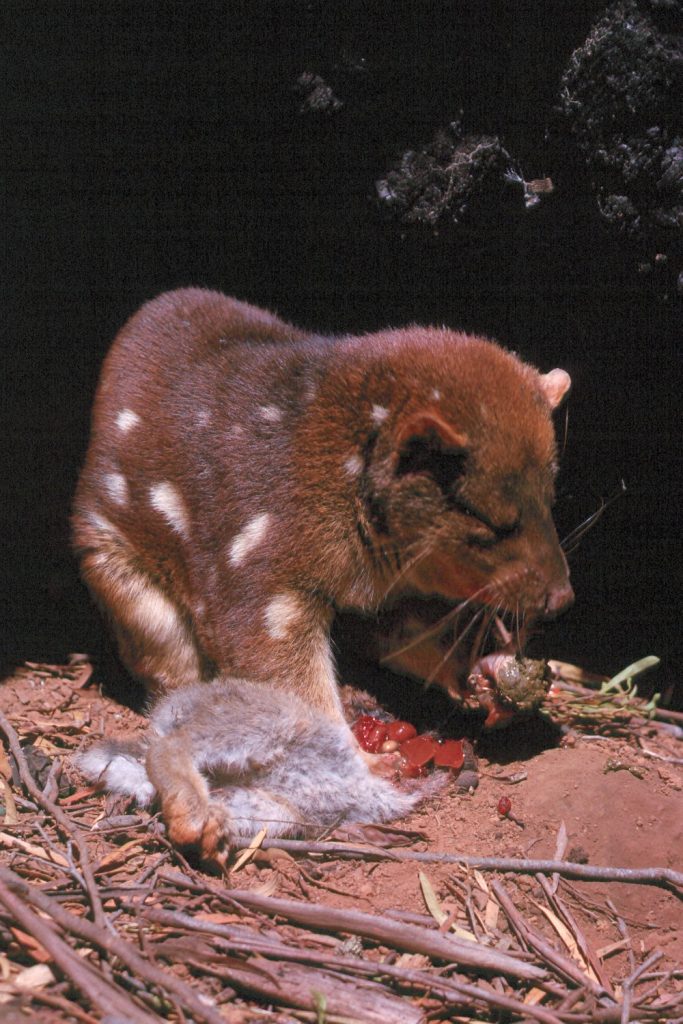
Social & Communication Behaviors
Even though Spotted Quolls are mostly solitary, they communicate among themselves with scent markings and vocalizations.
They use communal latrines( spots that multiple individuals use to defecate) and scent trails (scent-marked paths or areas) to make their presence known, especially during the mating season.
They produce growls and high-pitched screeches when threatened.
Reproductive Behaviour
The Tiger Quolls mate once a year. Mating usually happens in the winter, when males and females get together briefly to mate.
A female will mate with multiple males and bear offspring fathered by multiple males, ensuring genetic diversity.
Pregnancy lasts only 21 days, after which the female gives birth to 2-6 babies(Joeys). The newborns crawl into the mother’s pouch where they continue to develop for 10-12 weeks.
After that, the mother leaves them in a nursery den to hunt. The mother continues to feed them milk, gradually reducing as they start eating solid food the mother brings back from hunting.
Interesting Facts About The Spotted Quoll
Here is some other fascinating information about the Spotted Quoll.
Comparison with Other Quolls
Other Quolls, such as Eastern Quolls and Northern Quolls, are smaller compared to Spotted Quolls, weighing from 1.3 to 4.4 pounds(0.59 to 2.0 kilograms).
While the spots on the fur coat of The Spotted Quoll extend to the tail, they are limited to the body of other Quolls.
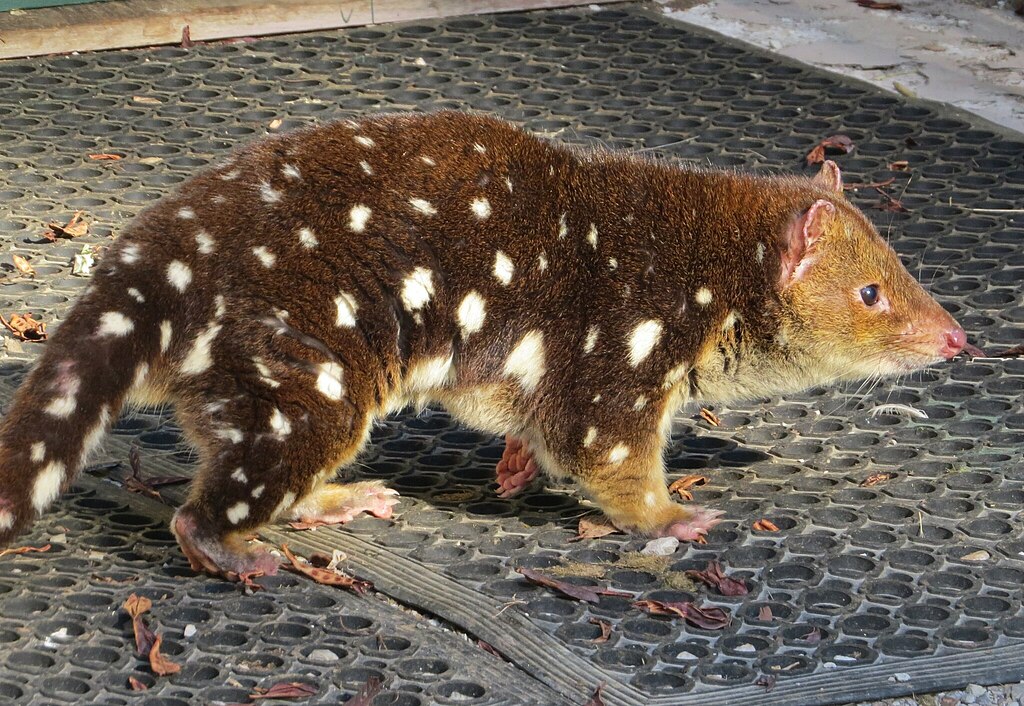
pimelea
Spotted Quolls inhabit mostly wet forests and woodlands, and other Quolls live in drier and open habitats.
While Spotted Quoll naturally occurs along the east coast of mainland Australia, other Quoll species are scattered across the mainland and the islands.
Also, their size and strength allow them to hunt larger prey, such as wallabies and possums, that other Quolls can’t tackle.
Special Adaptations
Spotted Quolls have special adaptations that help them survive in their habitats.
Agility and Climbing Skills
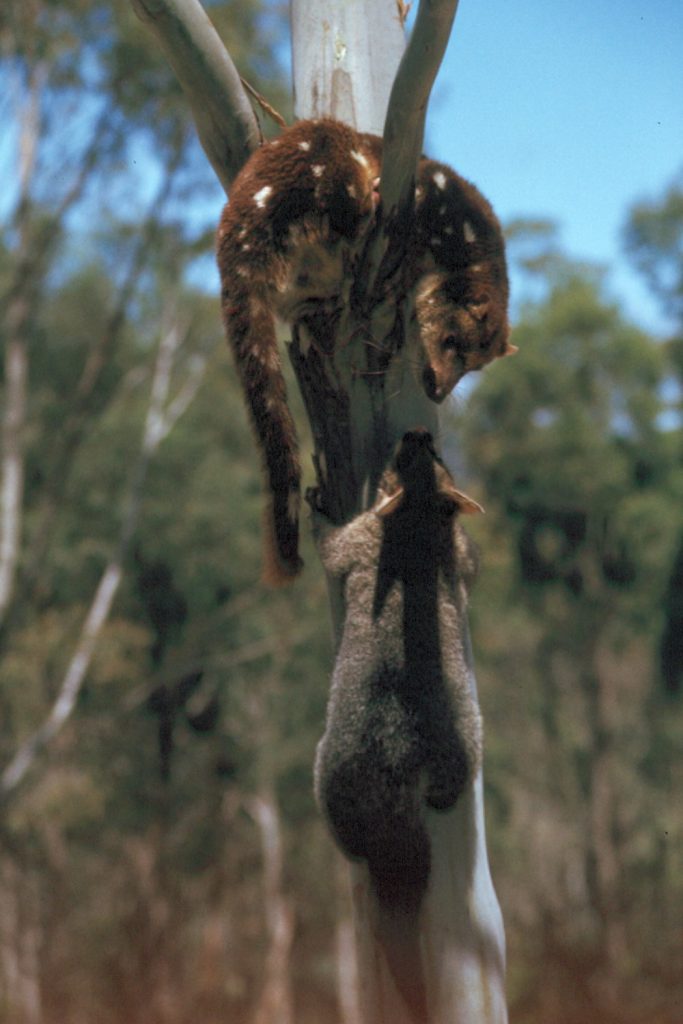
They are very agile animals and excellent climbers. Unlike many mammals, they can climb a vertical tree trunk and get back down head first.
They have ridged pads under their feet, providing grip for their climbing endeavors.
Camouflage
The spotted pattern of their coat helps them hide well from prey and predators in the shaded light in the forests.
Bite Strength
The Tiger Quoll has an impressive bite strength compared to its body weight. Their bite strength proportional to body weight is even greater than that of the Lion. They mostly target the neck or skull of their prey, ensuring a quick kill. This makes them very effective hunters.
Swimming Ability
Being good swimmers, Tiger Quolls expand their hunting range to wetlands and rivers.
Ecological Role
Being apex predators, they help maintain the balance in their habitats by controlling the populations of their prey, especially invasive species like rabbits.
Conservation Status
Let’s see how this important predatory marsupial is faring in the wild.
Threats to Survival
Spotted Quoll populations in the wild today face several threats.
One is the loss and fragmentation of habitats. A considerable amount of forests are cleared for agriculture, urban development, and logging, more prominently in Southeastern Queensland and Victoria, where loss of habitat can be as high as 70%.
Introduced predatory animals such as foxes and feral cats compete with Spotted Quolls for food and prey on their young, posing a threat to their survival.
Many Spotted Quolls get killed by motor vehicles too, especially at night when they are mostly active.
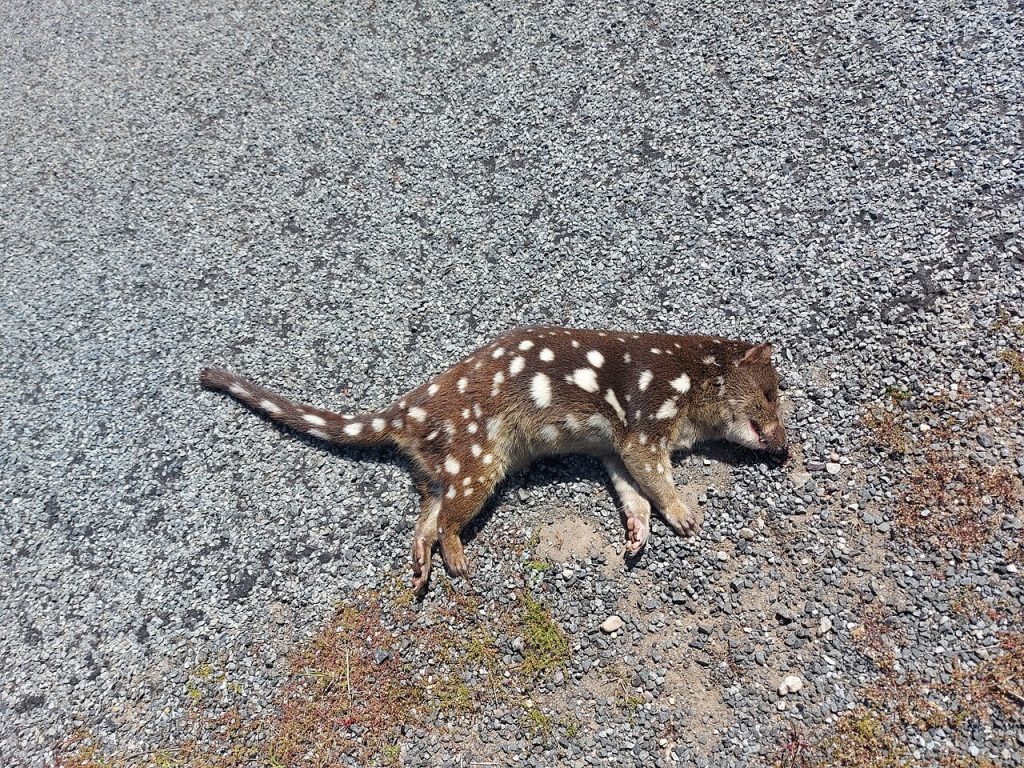
www.inaturalist.org
Disease outbreaks in the past have been linked to drops in Spotted Quoll populations, and there may be ongoing health threats still affecting their numbers.
Australia has many invasive alien species like rabbits, and the 1080 poison baits that are used to control them unintentionally harm Spotted Quolls too.
Conservation Efforts
The Tiger Quoll is listed “Near Threatened” by the IUCN red list, and various Australian states have declared it “Vulnerable” or “Endangered”.
Conservation attempts focus on protecting remaining habitats, establishing wildlife corridors to connect the fragmented habitats, and controlling invasive predators.
Camera traps, radio tracking, and surveys are used to monitor Spotted Quoll populations and assess their habitat needs and threats, providing information to help with targeted conservation efforts.
Efforts are being made to introduce Spotted Quolls to fenced sanctuaries and protected reserves with no predators, such as Booderee Botanic Gardens and other safe havens in New South Wales and Tasmania, too.
Conclusion
The spotted quoll, or tiger quoll (Dasyurus maculatus), the largest carnivorous marsupial in mainland Australia, is a remarkable animal with distinctive spotted fur, great agility, and a powerful bite.
This solitary and nocturnal hunter helps keep the balance in its habitats by controlling the populations of their prey, including some invasive species.
Their populations are threatened by habitat loss, invasive predators, diseases, and roadside mortality, and various conservation efforts are being made to protect them.

